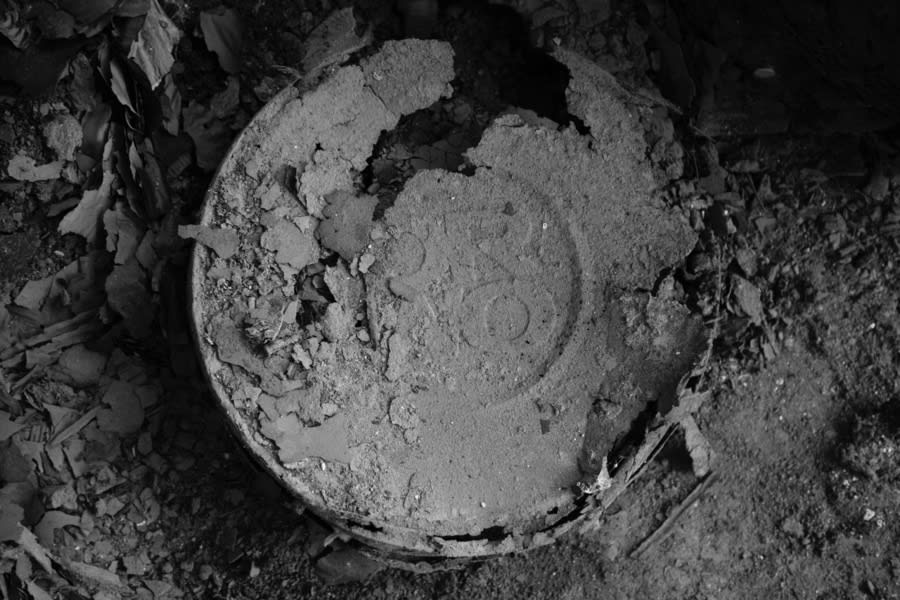Art Basel Viewing Rooms: Cataloging Time
Experimenter presents Cataloging Time, an exhibition by Bani Abidi, CAMP and Sohrab Hura that anchors itself within pioneering moving-image and photographic works by each artist, capturing a moment in time, recording, re-interpreting, cataloging and marking shifts in the order of things.
Bani Abidi’s four photographic works on view – Film Reels, Intercommunication Devices, Security Barriers, A Table-wide Country, The Address and Untitled (Files) catalog moments in time in the understanding of anxieties, of defning identities and the complex intertwined political histories of South Asia. Film Reels are a series of photographs of charred flm reels in the burnt site of a famous cinema in Karachi torched by a protesting mob. In A Table Wide Country (Catalog) a set of photographs is taken in the home of a fctitious character. Abidi looks at make-believe worlds and human eccentricities that often serve as psychological safeguards against life and memory. The character in A Table Wide Country is also a collector of war models, but his is an attempt to overcome. The character reacts to the history of a particular confict with his own narratives that are uneasy, provocative, but also perhaps therapeutic. Intercommunication Devices, Security Barriers and Untitled (Files) are all compilations and catalogs that question identities, anxieties and belongingness in a certain moment in history. A photographic work and a single channel video, The Address questions notions of time itself. Abidi commissioned a background painting resembling the set used for televised presidential speeches and played the image of this vacant set on TV sets in various public spaces in Lahore, Pakistan. The photographs, while attempting to examine a signifcant image, leave the viewers (both within and outside the photographs) caught in a before, after or perpetual moment by leaving the seat empty. The work hopes to raise questions about the relationship between civil society and the ever-changing face of political power in Pakistan.
CAMP presents three iconic works, the frst of which, Al Jaar Qabla Al Daar (The Neighbor Before the House) was generated by eight Palestinian families living in Jerusalem/Al Quds, a place where the usual sense of “neighbourhood” is broken by occupation and confict. Filmed with a PTZ (pan-tilt-zoom) CCTV camera, the entire flm is made by people whose commentary is heard live as they watched, and controlled the camera from inside their homes. Sometimes the voice looks for an image, at other times image provokes voice, or they separate into distant landscapes and innermost thoughts. The Annotated “Gujarat And The Sea” Exhibition is a body of photographs of a photographic exhibition and inquires into the history of seafaring activity out of Western India, whose mostlycolonial materials can be re-interpreted. A Photogenetic Line is a 100-foot long branching installation of cut-outs drawing from the photo archives of The Hindu, a 140-year old newspaper creating a fctional timeline of actual events across a fractured South Asia.
Sohrab Hura’s video The Lost Head & the Bird is a disorientating and absurd world, where the boundaries between fact and fction blur, and the undercurrents of hysteria, rage, euphoria and violence lurk beneath the surface. The work explores a frighteningly fast-changing, post-truth world where actions are fuelled by appeals to emotions and facts are increasingly ignored and acts as Cataloging Time a marker for the contemporary moment. Hura’s photographs from The Coast is a sequence of images taken along the Indian coastline beginning in 2013. While the photographs are made in real situations, the continuous changing context manipulates the line between what is fact and what is not. The Coast becomes a chronicler of a changing time in the subcontinent owing to the shift in the extremities of polarization and violence and the the silent habituation of it.
Cataloging Time brings together three artists whose practices are rooted in time-based media who in turn use their medium to reexamine time itself. The exhibition marks the shifting fundamentals of politics and society, identity and violence, the interpretation of truth – both real and engineered and the failures and triumphs of our dystopic world.



